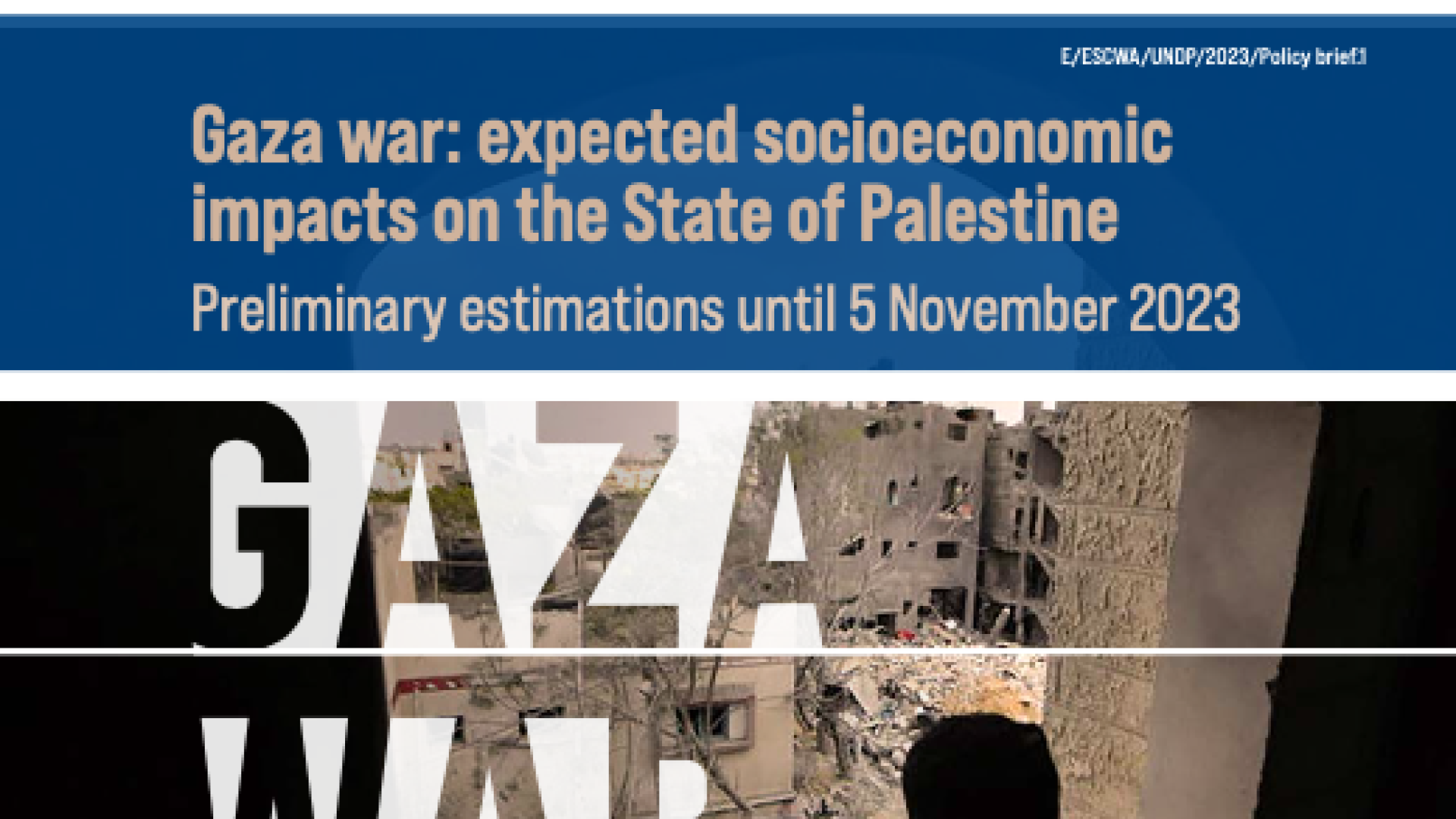Gaza War: Expected Socio-Economic Impacts on the State of Palestine | United Nations Development Programme
Gaza War: Expected Socio-Economic Impacts on the State of Palestine United Nations Development Programme


The Gaza War: Expected Socio-Economic Impacts on the State of Palestine

The war in Gaza continues unabated well past its first month, leaving behind massive losses of life and infrastructure damage and forcing displacements of unprecedented scale. The unfolding humanitarian emergency is also a development crisis. The continuation of the war comes with huge and compounding costs to all Palestinians, not only Gazans, now and in the near and medium-term future.
Introduction
The United Nations Development Programme (UNDP) and the Economic and Social Commission for Western Asia (ESCWA) are releasing on 9 November 2023, a joint rapid assessment entitled ‘The Gaza War: Expected Socio-Economic Impacts on the State of Palestine.’
UNDP and ESCWA have specific mandates by the United Nations to work to improve the economic and social conditions of the Palestinian people, and to substantively report on those conditions, respectively.
Assessment Overview
The assessment compiles data and employs various analytical tools, including rapid satellite damage appraisals, night-time light satellite imagery, and Computable General Equilibrium (CGE) economic modeling, to simulate the impacts of the war in Gaza on the entire occupied Palestinian territory at the one-month mark and for two-month and three-month scenarios.
The assessment examines the following:
- Impact on lives
- Buildings and infrastructure damages
- Health status
- Poverty and food insecurity
- Impacts on jobs and businesses
- Macro-economic performance
SDGs, Targets, and Indicators
| SDGs | Targets | Indicators |
|---|---|---|
| SDG 1: No Poverty | Target 1.2: By 2030, reduce at least by half the proportion of men, women, and children of all ages living in poverty in all its dimensions according to national definitions | Indicator not mentioned in the article |
| SDG 2: Zero Hunger | Target 2.1: By 2030, end hunger and ensure access by all people, in particular the poor and people in vulnerable situations, including infants, to safe, nutritious and sufficient food all year round | Indicator 4: Impacts on poverty and food insecurity |
| SDG 3: Good Health and Well-being | Target 3.4: By 2030, reduce by one-third premature mortality from non-communicable diseases through prevention and treatment and promote mental health and well-being | Indicator 3: Health status |
| SDG 8: Decent Work and Economic Growth | Target 8.5: By 2030, achieve full and productive employment and decent work for all women and men, including for young people and persons with disabilities, and equal pay for work of equal value | Indicator 5: Impacts on jobs and businesses |
| SDG 9: Industry, Innovation, and Infrastructure | Target 9.1: Develop quality, reliable, sustainable and resilient infrastructure, including regional and transborder infrastructure, to support economic development and human well-being, with a focus on affordable and equitable access for all | Indicator 2: Buildings and infrastructure damages |
| SDG 11: Sustainable Cities and Communities | Target 11.1: By 2030, ensure access for all to adequate, safe and affordable housing and basic services and upgrade slums | Indicator not mentioned in the article |
| SDG 16: Peace, Justice, and Strong Institutions | Target 16.1: Significantly reduce all forms of violence and related death rates everywhere | Indicator not mentioned in the article |
1. Which SDGs are addressed or connected to the issues highlighted in the article?
- SDG 1: No Poverty
- SDG 2: Zero Hunger
- SDG 3: Good Health and Well-being
- SDG 8: Decent Work and Economic Growth
- SDG 9: Industry, Innovation, and Infrastructure
2. What specific targets under those SDGs can be identified based on the article’s content?
- Target 1.2: By 2030, reduce at least by half the proportion of men, women, and children of all ages living in poverty in all its dimensions according to national definitions
- Target 2.1: By 2030, end hunger and ensure access by all people, in particular the poor and people in vulnerable situations, including infants, to safe, nutritious and sufficient food all year round
- Target 3.4: By 2030, reduce by one-third premature mortality from non-communicable diseases through prevention and treatment and promote mental health and well-being
- Target 8.5: By 2030, achieve full and productive employment and decent work for all women and men, including for young people and persons with disabilities, and equal pay for work of equal value
- Target 9.1: Develop quality, reliable, sustainable and resilient infrastructure, including regional and transborder infrastructure, to support economic development and human well-being, with a focus on affordable and equitable access for all
3. Are there any indicators mentioned or implied in the article that can be used to measure progress towards the identified targets?
- Indicator 4: Impacts on poverty and food insecurity
- Indicator 3: Health status
- Indicator 5: Impacts on jobs and businesses
- Indicator 2: Buildings and infrastructure damages
The article discusses the war in Gaza and its impacts on various aspects of life in Palestine. The identified SDGs are connected to the issues highlighted in the article. The targets under these SDGs are relevant to addressing the challenges faced by the Palestinian people due to the war. The indicators mentioned or implied in the article can be used to measure progress towards the identified targets. For example, the impacts on poverty and food insecurity (Indicator 4) can be measured to assess progress towards Target 1.2. Similarly, the health status (Indicator 3) can be monitored to evaluate progress towards Target 3.4. The impacts on jobs and businesses (Indicator 5) and buildings and infrastructure damages (Indicator 2) can be measured to track progress towards Targets 8.5 and 9.1, respectively.
Behold! This splendid article springs forth from the wellspring of knowledge, shaped by a wondrous proprietary AI technology that delved into a vast ocean of data, illuminating the path towards the Sustainable Development Goals. Remember that all rights are reserved by SDG Investors LLC, empowering us to champion progress together.
Source: undp.org

Join us, as fellow seekers of change, on a transformative journey at https://sdgtalks.ai/welcome, where you can become a member and actively contribute to shaping a brighter future.







